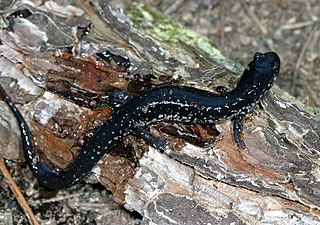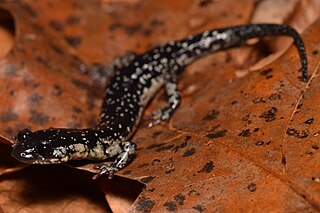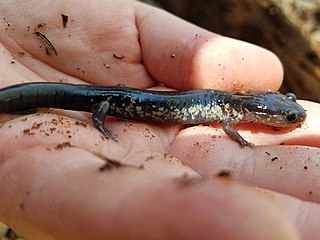
Plethodon is a genus of salamanders in the family Plethodontidae. They are commonly known as woodland salamanders. All members of the genus are endemic to North America. They have no aquatic larval stage. In some species, such as the red-backed salamander. Young hatch in the adult form. Members of Plethodon primarily eat small invertebrates. The earliest known fossils of this genus are from the Hemphillian of Tennessee in the United States.

The northern slimy salamander is a species of terrestrial plethodontid salamander found throughout much of the eastern two-thirds of the United States.

The western slimy salamander, also known as the whitethroat slimy salamander or white-throated slimy salamander, is a species of salamander. It is endemic to the United States of America and found in two disjunct populations, one from Missouri to Oklahoma, and Arkansas, and another in south-central Texas.

The Cheoah Bald salamander is a species of salamander in the family Plethodontidae endemic to the state of North Carolina in the United States. Its natural habitat is temperate forests and it is threatened by habitat loss. It was formerly considered a variant of the red-cheeked salamander until it was found to be a distinct species.

The white-spotted slimy salamander is a species of salamander in the family Plethodontidae endemic to the Eastern United States. It is one of 55 species in the genus Plethodon, and was one of the first to be described of its cogeners. The preferred habitat of this species is under logs and leaf litter in shaded hardwood forests and wooded floodplains, and often forages on the forest floor on wet nights. It was found that with increasing temperatures, the aggression in this species also increases. In the plethodon genus, species have a lungless morphology, restricting nearly all gas and water exchange transport to the body surface. This species mainly consumes insects, including ants, centipedes, springtails, crickets, millipedes, slugs, snout-beetles, and earthworms. Common predators of this species are gartersnakes, copperheads, and birds. One of their predator defense mechanisms is the release of noxious/sticky substances through the skin by the dorsal granular glands. Another predator deterrent is when touched, this species will freeze in place and become immobile. This species of Plethodon are mostly terrestrial and deposit their direct-developing eggs on land that omits the aquatic larval stage characteristic of most amphibians, therefore this species is not restricted to aquatic habitats for reproduction and dispersal. This species, along with other Plethodontid salamanders, are frequently parasitized by Trombicula mites.

The red-cheeked salamander, also known as the Jordan's salamander, Jordan's redcheek salamander, or Appalachian woodland salamander, is a species of salamander in the family Plethodontidae. It is endemic to the Appalachian Mountains in the southeastern United States.

The Cumberland Plateau salamander is a species of salamander in the family Plethodontidae. It is endemic to the Cumberland Plateau, the southeastern United States. Its natural habitat is temperate forests. It is threatened by habitat loss.

The Kiamichi slimy salamander is a species of salamander in the family Plethodontidae endemic to the United States, has a natural habitat of temperate forests, and is found over a small range. This nocturnal species is mainly threatened by habitat loss and was first described by Highton in 1989. It is rated as a vulnerable species by the International Union for Conservation of Nature.
The Louisiana slimy salamander is a species of salamander in the family Plethodontidae. It is endemic to the United States where it is only known from northern Louisiana and southern Arkansas. Its natural habitat is hardwood forests. Little is known about this species, but it appears to be common within its range with some populations likely impacted by deforestation.
The South Mountain gray-cheeked salamander is a species of salamander in the family Plethodontidae, endemic to the state of North Carolina in the United States, where it is only found in the South Mountains. It was formerly considered a variant of the red-cheeked salamander. Its natural habitat is temperate forests. It is threatened by habitat loss.

Plethodon punctatus, commonly known as the Cow Knob salamander or white-spotted salamander, is a species of salamander in the family Plethodontidae. It is endemic to high mountain forests on the border of Virginia and West Virginia in the United States. Nearly all occurrences are on Shenandoah Mountain, Nathaniel Mountain and Great North Mountain in George Washington National Forest. Cow Knob salamanders are a member of the P. wehrlei species complex, which includes many other Appalachian salamanders historically referred to Plethodon wehrlei.

The Chattahoochee slimy salamander (Plethodon chattahoochee) is a species of salamander in the family Plethodontidae. It is endemic to the Appalachian Mountains in the United States, where it is found only in the Chattahoochee National Forest and Nantahala National Forest in the states of Georgia and North Carolina. Its natural habitat is temperate forests. It was once classified within the northern slimy salamander (P. glutinosus) until it was found to be a distinct species. Its range narrowly intersects with the northern slimy salamander, the Atlantic Coast slimy salamander (P. chlorobryonis), and the southern Appalachian salamander (P. teyahalee) and widely intersects with the red-legged salamander (P. shermani), and it is known to hybridize with the latter three.
The Ocmulgee slimy salamander is a species of salamander in the family Plethodontidae. It is endemic to the state of Georgia in the United States, where it is found in regions of the coastal plain and Piedmont that are associated with the Ocmulgee River drainage system. It is only known from a few counties, and due to this restricted range, it is at high risk of extinction. Many populations of this species are already experiencing precipitous declines, with some even possibly being extirpated.
The Savannah slimy salamander is a species of salamander in the family Plethodontidae. It is endemic to the state of Georgia in the United States, where it is restricted to the Atlantic coastal plain in Burke, Jefferson, and Richmond counties. This distribution reaches its eastern limit at the Savannah River. Its natural habitat is bottomland hardwood forest. Population analysis indicates a precipitous decline in the population of this species, and it is becoming extirpated in many areas due to development; for example, the habitat at the type locality of this species was partially destroyed by a housing development.
The Dixie Caverns salamander is a species of salamander in the family Plethodontidae. It is endemic to the state of Virginia in the United States. It is most often found in Roanoke County, but several specimens have been recorded in surrounding counties. It was commonly confused with Wehrle's salamander and was merged with that species shortly after description, but a 2019 study reaffirmed it as a distinct species.
The yellow-spotted woodland salamander is a species of salamander in the family Plethodontidae. It is endemic to the United States, where it is distributed throughout the Cumberland Plateau in the states of Kentucky and Tennessee. Its natural habitat is temperate forest. It was long considered to be both an isolated western population and a unique yellow-spotted color morph of the Wehrle's salamander, but a study published in 2019 found it to be a distinct species.












